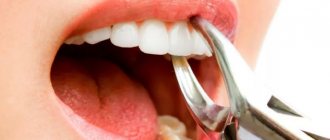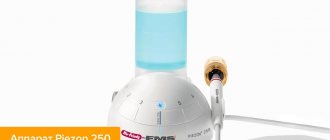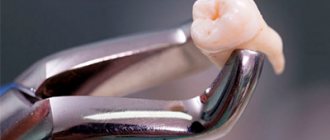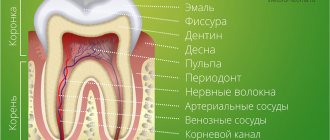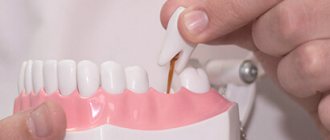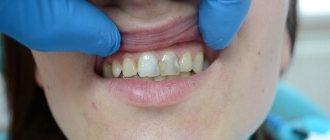On each side of the adult jaw there are several types of teeth: two front ones, called incisors, one eye - a canine, and two premolars and molars. Teeth of one type differ from another not only in functionality and appearance, but also in structure. The weakest are the incisors, which are responsible for biting, tearing food and are not adapted for chewing it, and the strongest are the fangs located behind them in the corners of the jaws.
Each of the fangs has a powerful root and an elongated crown. Premolars, responsible for chewing food, are distinguished by a wide chewing surface with two tubercles. And the chewing surface of the molars, which grind food, is equipped with 4–5 tubercles. Anomalies requiring orthodontic intervention and, in particular, treatment with braces most often occur on the eye teeth.
Dystopic wisdom tooth: what is it?
A dystopic wisdom tooth is a third molar, also known as a “figure eight”, which is positioned incorrectly relative to the rest of the dentition. Such a tooth almost always needs to be removed.
A special case of a dystopic wisdom tooth is an unerupted, but fully formed figure eight, which turns out to be turned parallel to the gum. In this case, the tooth is there, although it is not visible, and it is in an incorrect position, so we can talk about dystopia.
Two examples of dental dystopia
Causes of dystopic wisdom teeth
Very often, dental dystopia is associated with genetic reasons. A predisposition to shifting dentition is inherited along with small jaw size and other aspects of individual appearance that can cause teeth to shift. Doctors call other factors that provoke improper growth of molars, incisors and fangs:
- atypical formation of the tooth germ in the embryonic period;
- macrodentia, partial adentia, supernumerary teeth and other diseases;
- improper eruption (can be caused by early removal of the primary bite);
- small jaw size;
- mechanical damage, dental trauma;
- bad habits such as chewing foreign objects, thumb sucking (affect the development of malocclusion);
- late eruption of canines, for which there is no longer room in the dentition.
Modern dentistry successfully cures the patient, regardless of the causes of tooth dystopia and its position in the gum. The main thing is to seek help in time.
Why do teeth become crooked?
It is quite difficult to figure out why teeth are crooked, since there are many reasons for this anomaly. But there are factors that help explain why teeth grow crooked:
- Personality characteristics: narrow jaw and large teeth that simply do not have enough space in the mouth to grow straight.
- Bad habits: thumb sucking or using a pacifier for too long in children, lip biting, pencil chewing. All these habits lead to the fact that the teeth do not close completely, and the upper or lower jaw lengthens.
- Refusal to treat baby teeth. Unfortunately, there are still dentists who claim that caries in baby teeth does not need to be treated and simply remove the child’s diseased tooth. This cannot be done, since early removal of a baby tooth will lead to displacement and curvature of the entire dentition.
- Mouth breathing: If a person breathes only through the mouth, the shape of the palate gradually changes, which can also cause crooked teeth.
But most of the factors associated with crooked front or any other teeth are laid down in childhood, even in the womb. During the formation of the fetus, dental anomalies of one of the parents can be transmitted to the baby. But even if a child does not have a genetic predisposition, crooked teeth may still appear.
The reasons will be explained by orthopedic dentist of the 32Dent clinic Lyudmila Vladimirovna Ponomareva: “Most dental problems begin in childhood. This also applies to the causes of crooked teeth. If a baby is fed from a nipple with a hole that is too large, he will not make any effort to suck and jaw growth will not be stimulated. This also applies to nutrition: a child’s diet should contain a certain amount of hard food. Thanks to this, baby teeth wear down evenly and jaw growth is stimulated.”
But even if you know exactly why your teeth are crooked, it doesn’t change anything. Unfortunately, there are few qualified dentists who can eliminate malocclusion, and correcting crooked teeth in adults and adolescents is a rather lengthy process.
Types of wisdom teeth dystopia
Wisdom tooth dystopia is classified depending on which direction the crown is shifted. The following types of disease are distinguished:
- vestibular (forward displacement);
- oral (teeth located behind the entire row);
- mesial (forward bend);
- distal (backward tilt);
- with supraposition (above the dentition);
- with infraposition (below the dentition);
- with tortoposition (the tooth is rotated around its axis);
- with transposition (the tooth is in the place of another tooth).
In the most severe cases, you can observe the appearance of a tooth outside the oral cavity: for example, inside the nose. This is very dangerous and requires immediate treatment.
Symptoms of dystopia
Symptoms of dental dystopia are most often visual and easily noticeable. It is enough to look at the position of all the elements of the dentition to see that some of them are in the wrong places or are simply growing unevenly. Other symptoms:
- there is no tooth in the bite, and the period of eruption has already passed;
- inflammation and pain are felt at the site of the wisdom tooth;
- The wisdom tooth did not appear on time
It is interesting that in a number of cases there is no wisdom tooth at all - it does not form and does not erupt. Dentists call this option a variation of the norm.
Consequences of dystopia
Although dental dystopia does not seem like a terrible disease, it can create many problems. This is why wisdom teeth that have grown incorrectly are most often removed. Among the most unpleasant consequences of the disease:
- disruption of the entire dentition, because due to one incorrect element, the rest move or cannot erupt correctly;
- injury to the tissues of the cheeks, tongue, lips, which can cause ulcers and even provoke the development of tumors;
- complication of oral hygiene, which leads to inflammation, caries, both on the dystopic and adjacent teeth;
- the appearance of gingival pockets where bacteria accumulate, leading to pericoronitis;
- impaired chewing function, which in turn reduces the quality of food and can lead to deterioration of the gastrointestinal tract;
- difficulty pronouncing words, poor diction;
- violation of the facial skeleton, unaesthetic appearance of the lower part of the face.
Almost always, dystopia leads to unpleasant aesthetic consequences, which causes complexes and rejection of one’s appearance in the child, and then in the adult. Of course, this can be worked out with a psychologist, but it is much wiser and more correct to deal with the cause than to deal with the consequences.
Overview of correction methods
Each method of correcting crooked teeth has its own characteristics. To figure out how to correct very crooked teeth, consider all the means that are used for this:
- Braces. These are small plates made of ceramic or metal that are attached to each individual tooth and connected to each other with a special arch. The plates apply uniform pressure on the teeth, gradually leveling their position. Most models of braces are installed on the front part of the teeth, so the plates are visible when speaking. But there are also special, lingual braces. They are placed on the inside of the teeth. This design is more expensive, but it does not spoil the smile at all.
- Mouthguards. These are removable plastic structures that the patient can remove and install himself. It is important that the more often the trays are used, the faster a positive result will be achieved. Typically, mouthguards are used to correct crooked front teeth. The mouth guards themselves are used to correct the bite in children, and they are often placed on adults only to consolidate the achieved result.
- Trainers. Removable devices that are worn at night. They are used only to correct minor malocclusions and crooked teeth.
- Plates. Made from plastic or metal. They are attached to teeth or crowns with special hooks. Most often used to correct bite in children with small defects.
Veneers. In fact, these are onlays that do not eliminate a tooth defect, but only hide it. Therefore, the question of whether veneers will correct crooked teeth can have only one answer: it is physically impossible if the entire dentition is deformed. But in fact, installing veneers on crooked teeth will help if their surface is uneven. In this case, veneers will simply hide the desired areas- Lumineers. Their installation also allows you to correct minor defects. In fact, lumineers are similar to veneers: they are also glued to the surface of the tooth to level it. But lumineers are thinner than veneers, although this does not affect their strength.
- Restoration and prosthetics of crooked teeth. This is a special type of treatment in which each tooth is straightened individually with crowns or composite material. Under the light of a special lamp, it quickly hardens and is completely indistinguishable from an ordinary tooth. The only disadvantage of composite restorations for crooked teeth is that the material can be stained with food coloring.
Sometimes even braces or veneers are not enough to straighten crooked teeth. A crooked tooth can be corrected with a crown, but if the dentition is deformed due to the eruption of a wisdom tooth or anatomical abnormalities of the jaw, surgical intervention may be required. For example, straightening the dentition in some patients can only be done by removing a wisdom tooth, which puts pressure on neighboring teeth and moves them.
Diagnosis of dystopia
An orthodontist or even a dental therapist can easily determine tooth dystopia during a routine examination if the anomaly is not complex. In some cases, when an element of the dentition remains in the gum, ends up in the palate or another place, during the examination one can only suspect a problem.
If the doctor has not found one of the teeth that should have already erupted in a child (or an adult, if we are talking about eights), he will refer the patient for an x-ray examination. The picture clearly shows all the irregularities and you can see the formed teeth in the soft tissues. To clarify the position and for subsequent treatment, arthopantomography, creation of plaster models of the jaws, and teleradiography are used.
Consultation with an orthodontist
Parents came to the reception with a 12-year-old teenager. The boy's problem is that the fang does not grow in the same row with his teeth, but in front of the entire row. This does not look very nice, and also leads to poor hygiene on this side, since it is difficult to properly clean unevenly growing teeth. The teenager was treated by a district orthodontist in a public clinic for 1 year. The calculation was then made only from a panoramic image. The treatment was carried out using a plate, which was supposed to move the upper row of teeth apart to make room for the canine and, with the help of the anterior arch, direct it in the desired direction. Also, the goal of the district orthodontist was to correct the distal occlusion by changing the inclination of the upper anterior teeth. Over the course of a year, the upper row of teeth was moved apart by a plate to the point of extreme closure of the lower and upper teeth, but this did not provide enough space. Since the parents did not like the situation with the canine, and the previous orthodontist somehow doubted whether to make a new plate or put on braces, and whether it was necessary to remove the fours, the parents came with their son for a consultation with the orthodontist at Olga Baranova’s ORTHODONT PROJECT on the recommendation of friends.
Upon examination, she indicated an incorrect bite, too straight position of the front teeth, crowding of teeth in both the upper and lower dentitions. In addition to simply meeting the upper and lower teeth, the cusps of the upper teeth should fit between the cusps of the lower teeth, forming a tight row. On one side, the child’s teeth did not close at all (there was a gap left), and on the other, the cusps rested on the cusps – which is wrong.
Parent questions:
- Do I need to remove teeth to make room?
- Should I make a new plate or put on braces?
- Should I put on braces now, or wait until the last chewing teeth grow in, the child becomes more conscious and brushes his teeth better, and is less shy?
- How long will the treatment take?
The orthodontist explained that it is quite possible to do without removing the fourth chewing teeth. Treatment on a plate will not give the expected result, since it is necessary to work on both the upper and lower jaws. Treatment should not be postponed, since the “sevens” are now emerging, there is potential for growth, and it will be easier to move the teeth. braces , both external and internal, if you want to make the treatment invisible. The approximate duration of orthodontic treatment is about 2 years, maybe less, but it’s difficult to say without additional calculations.
The parents and the teenager agreed to start treatment with braces at Olga Baranova’s ORTHODONT PROJECT. Having received a list of necessary examinations and consultations, they began preparing for treatment.
Video recording of the consultation (the recording is published with the consent of the parents):
When is the best time to treat dental dystopia?
Like any dental disorder, dystopia should be treated immediately after the problem is discovered. The easiest time to change the position of teeth is during childhood and adolescence (up to about 18 years of age). This is due to the time of formation of the jaw bones. Until adulthood, the bone is still quite soft, which makes it easy to align the bite.
Sometimes, although rarely, trainers are used to treat dystopia. Read more about them in the article: Trainers for teeth straightening: description, varieties, tips for use
If we are talking about dystopic molars , then they are almost always removed. The third molars themselves are considered an atavism and an optional element in the dentition; moreover, their treatment is associated with problems and difficulties. Therefore, doctors do not try to save these teeth.
Sometimes treatment is associated not with removal, but with grinding of the tooth. This decision is made if the dystopic element does not interfere with the chewing function and does not violate the aesthetics of the oral cavity. In this case, it is recommended to be constantly monitored by a doctor, since such elements of the dentition are easily affected by caries. Moreover, the consequences are much more serious than in ordinary cases: incorrect tooth position stimulates the development of bacteria, inflammation, and complications.
Installation of braces for the treatment of canine dystopia
Removal of dystopic wisdom tooth
Removing a dystopic wisdom tooth is a fairly serious operation that requires professionalism and care from the doctor. Incorrect actions can lead to dislocation of adjacent teeth, lower jaw, injury to the mandibular canal and other problems. Therefore, it is very important to contact experienced specialists who are familiar with the specifics of removing complex teeth.
Indications for removing a dystopic tooth
Clear indications for removal:
- detection of a jaw cyst;
- traumatic dystopia;
- diseases of the jaw caused by this tooth;
- difficulties in treating caries in adjacent teeth;
- the appearance of pulpitis and periodontitis.
The practice is that the decision to remove a child is made taking into account all these factors. In an adult, it is more likely to decide whether to keep a tooth or not – removal is considered a universal solution, the simplest and safest. They resort to it in almost all cases.
Stages of removing a dystopic wisdom tooth
The removal operation is carried out in several stages. Compliance with technology allows you to protect the patient and simplify the operation for the doctor. Also, before starting work, detailed studies must be carried out: a full x-ray of the jaw is taken, all available caries is cured, etc.
During tooth extraction, the surgeon performs the following actions:
- Introduction of anesthetic. This may be local anesthesia or general anesthesia if several teeth are to be removed at once.
- Complete exposure of the tooth. To do this, a flap of mucous membrane and periosteum are peeled off.
- I sawed off the walls using a drill. This is necessary to align the element and make it easier to remove.
- Tooth extraction. The entire molar is removed using forceps. If the tooth was previously destroyed, its fragments are removed. It is important that the doctor removes all the fragments, otherwise inflammation will occur.
- Application of antiseptics to prevent the development of wound infection.
- Returning the mucosal flap to its place.
- Applying seams.
Once the wound is stitched, the operation is over, but the treatment is not. After a week, you should definitely see a doctor to have the stitches removed. It is also advisable to be observed by a specialist for 1-2 months to make sure that the removal had no consequences.
Removal of a dystopic tooth in pictures
Forecast of dystopia
The appearance of a dystopic tooth in a child is not such a serious problem (especially if there is only one). Before a person’s facial skeleton stops growing, the position of the main teeth can be normalized quite quickly. Therefore, it is recommended to begin treatment immediately after identifying the problem. In this case, all the teeth will most likely fall into place and in the future, in adulthood, will no longer cause concern.
If correction of dystopia in an adult is required, this almost always causes many difficulties. After 18-20 years, teeth are no longer so mobile, so correcting their position requires many preparatory interventions. It is much easier to remove a problematic tooth than to try to put it back in place.
Being cured in a timely manner, dystopia has virtually no negative impact on a person’s future life. Most often, the correct bite is maintained for a long time and does not require supervision by a doctor.
Crooked front teeth in adults
Teeth can also become crooked in adulthood, for example, as a result of injury or the same bad habits. If you constantly hold a pencil in your mouth, bite your nails or seeds, then sooner or later chips and irregularities will appear on your teeth, and they will have to be corrected. Many patients at dental clinics also complain that their smile is ruined by crooked, that is, incorrectly erupted wisdom teeth. Let's say more, even evenly standing “eights” can change the shape of the dentition - for example, in the case when the patient does not have a very large jaw and there is simply not enough space for “wise” teeth.
However, most often dental anomalies in adulthood appear due to the long-term absence of one or more teeth. If they are not replaced in time with dental implants or at least temporary dentures, then the dentition will soon begin to move apart, trying to fill the gaps that have formed. You know the result of such movements - crooked teeth and their improper closure.
Prevention of dystopia
Dentists are confident that if you carefully monitor your child’s dental health from early childhood, you can avoid most bite problems. Dystopic teeth are no exception, because their appearance is not always associated with hereditary factors. To prevent dystopia, doctors recommend the following:
- proper nutrition, adherence to the daily routine of a pregnant mother;
- prevention of jaw injuries from an early age;
- regular visits to the dentist, wearing devices to correct malocclusion;
- giving up bad habits (including weaning off the pacifier after a year and from thumb sucking in sleep), etc.
If you and your child regularly visit a dentist, he will give recommendations on what exactly to do in your case.
What to do if the child’s teeth grow in the second row?
When a doctor sees a tooth above a patient’s tooth, he immediately understands what’s wrong. First, the orthodontist removes the baby tooth. After this, the permanent tooth will move into place on its own under the action of the tongue muscle, if there is enough space. But what to do if a child has a lack of space for molars?
The primary task of the dentist and parents will be to restore normal breathing. At this stage, it is necessary to “retrain” the muscles of the mouth to work differently. This is where trainers or mouthguards come to the aid of specialists.
Orthodontic appliances solve several important problems:
- train the muscles of the oral cavity, stimulating their natural development;
- correct the direction of development of the child’s jaws;
- correct the position of the tongue in the oral cavity;
- teach the child to breathe through the nose;
- get rid of bad habits.
Wearing trainers is most often considered as a preparatory stage. After this, more serious orthodontic treatment begins with the use of braces. However, here the first step is the most important, since the effectiveness of further work depends on it.
Conclusions. Expert advice
Dystopia is the incorrect position of a tooth in the jaw: its displacement forward or backward, down or up, as well as rotation around its axis or tilt. The appearance of such an anomaly is associated both with hereditary factors and with bad habits or mechanical damage to the jaw. The sooner dystopia is detected, the easier it is to cure. In adults, the wisdom tooth most often found to be dystopic is the third molar, because there may simply not be enough space in the jaw for it to erupt.
The consequences of such anomalies include general malocclusion, frequent inflammatory diseases, impaired chewing function, and much more. Depending on the complexity of the case, dystopia is treated either by tooth extraction or with the help of braces. If the decision is made to remove it, it is important to carry out the operation carefully and correctly. If treatment is started on time, the prognosis for the disease is positive.
Preparing for treatment
A panoramic photograph of the teeth was taken, an X-ray of the skull in a lateral projection (TRG-lateral), and impressions of the teeth were taken. The teenager underwent consultation with an osteopath, speech therapist, and pediatric dentist. Photometry was taken - the face and teeth from different angles.
Initial situation:
At a consultation with an osteopath , the osteopath did not identify any significant problems regarding the musculoskeletal system that could affect the bite. A small correction is proposed after each visit to the orthodontist in order to compensate for the influence of orthodontic equipment - to relieve tension in the bones of the skull, temporal joints, and neck.
At a consultation with a speech therapist , the condition of the muscles of the lips and tongue was tested. A decrease in tongue muscle tone and improper swallowing were revealed. A list of exercises is given that you can perform independently to train the muscles of the tongue and neck.
A consultation with a pediatric dentist revealed caries on one of the teeth, which must be cured before orthodontic treatment .
Consultations with specialists are provided free of charge. A feature of the treatment at Olga Baranova’s ORTHODONT PROJECT is an integrated approach to treatment - the interaction of different specialists aimed at eliminating all negative factors that disrupt the position of the teeth, which gives more stable results of orthodontic treatment .
The results of all consultations and examinations were sent to the orthodontist . The doctor carried out the necessary calculations, and on the second visit she explained the treatment plan, and also offered several braces to choose from.
The Damon self-ligating bracket system was chosen. In this bracket system, the braces are small in size with rounded edges. braces on the upper front teeth , which are less noticeable to others. It is better to use Damon Q metal braces to protect the upper teeth from excessive wear. When smiling and talking, the lower teeth are covered by the lip, and the aesthetics are not greatly affected.
After the brace system was approved, a treatment contract was signed and the cost of the brace system was paid. Payment for treatment can be made in full or in stages - half when fixing braces
and the balance in equal parts at each visit.
To maintain the health of the teeth while wearing braces, before fixing the braces as a gift, hygienic preparation of the teeth , including removing plaque using the Air Flow method, removing tartar with ultrasound, and polishing the surface of all teeth. The hygienist explained on a model the rules for brushing teeth with braces with a special orthodontic brush, showed how to use dental brushes, a single-tuft brush and special dental floss to clean braces and interdental spaces.
The next step will be fixing the braces , which is the beginning of orthodontic treatment.
